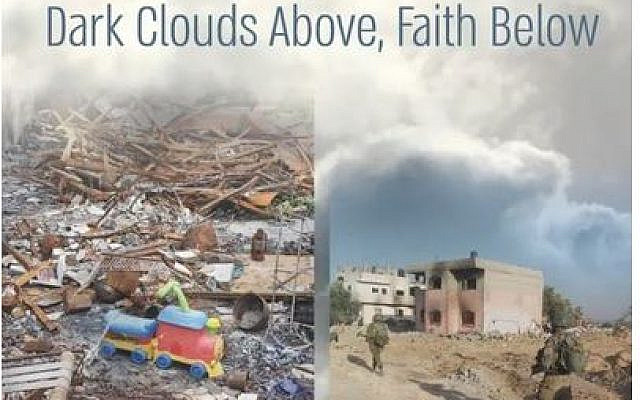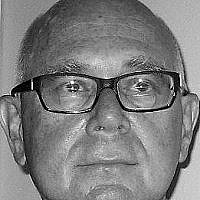Book review: Dark Clouds Above, Faith Below
Rav Kook was known for many things. Some of them include his love of the land of Israel, his love for his fellow Jews, and that he was a significant Torah scholar. The same can be said for Rabbi Moshe Taragin, Ram at Yeshivat Har Etzion in Gush Etzion. Having been in that role for over a quarter century, he has inculcated a generation of students.
Taragin has his first book out, but it’s one that he and no one would have wanted to be printed. In Dark Clouds Above, Faith Below (Kodesh Press), he shares his raw emotions and thoughts in 30 chapters written in the hours, days, weeks, and months after October 7.
These are not simple times, and what is needed is to construct durable and nuanced faith to navigate this storm. Taragin is a master of nuance, and he navigates the reader through the raging waves of the storm, which continues as of this writing. But with the knowledge that every storm, like this one, has an ending.
The book starts with a chapter aptly titled No Words, written on Sunday, October 8. He notes that this is not the time for ideas, drawing larger conclusions, or searching for meaning. It is a time to cry, and cry—to cry for our people and our land, for the name of Hashem, which was so horribly desecrated.
Taragin is a close student of Rav Yehuda Amital, former Rosh Yeshiva of Yeshivat Har Etzion. Many of Rav Amital’s ideas are quoted in this thoughtful and insightful book. Rav Amital often said that the Shoah was a massive chillul Hashem for the disgrace that the Jewish people had to endure.
Rabbi Yakov Love (formerly of Passaic) was often asked to explain why certain calamitous things happened, to which he would incisively answer, “I’m not God’s CPA.” The ways of Hashem elude human comprehension, and we certainly can’t wrap our heads around this catastrophe. While we can’t know with certainty why things happen, the book is Taragin’s attempt to make some sense of what happened.
A noteworthy idea he makes a few times is that there is something different about this catastrophe. While there have been thousands of pogroms in years past, what is different is that we now have our land and our army. And despite whatever shortcomings were exposed, our army, with Hashem’s help, will punish the murderers and continue to protect us.
And most importantly, this is the first time in Jewish history that a pogrom against our people was followed by a war. After previous pogroms, we had little choice but to lick our wounds and move on, but not this time.
In The Ideology of Hesder, Harav Aharon Lichtenstein, who was co-Rosh Yeshiva with Rav Amital, wrote a tour de force of a programmatic essay showing that hesder was lchatchila, not b’di’eved. HaRav Lichtenstein writes that “The midrash (Kohelet Rabbah, 7:4) equates the renunciation of g’milut hasadim with blasphemy; and the Gemara in Rosh Hashanah states that Abbaye outlived Rabbah because he engaged in both Torah and g’milut hasadim whereas Rabbah had largely confined himself to the former. When, as in contemporary Israel, the greatest single hesed one can perform is helping to defend his fellows’ very lives”.
The famous kochi v’otzem yadi passage in Devarim 8:17, “My own power and the might of my own hand have won this wealth for me,” has often been used to diminish the pride one should feel in one’s accomplishments and military victories.
On that idea, Taragin articulately writes that every human project demands human initiative alongside faith. Unlike other spheres, though, initiative in war requires self-esteem and personal pride for courage and bravery. Though it feels like excess self-attribution, military pride, and celebration of the courage of the IDF chayalim are all necessary initiatives Hashem desires during war.
Taragin notes that without humans feeling pride in their accomplishments, our military initiatives would be hollow and ineffective, and we would rely entirely on miracles. Serving in the army is one area of religious experience in which belief in Hashem and attribution to human effort don’t clash.
Another trait Taragin shares with Rav Kook is his optimism. In many chapters, he tries to find ways to lock into the current atmosphere of unity. While Israel has been called the startup nation, Taragin calls us the start-over nation.
This is a book Taragin didn’t want to write, but it must be read. He writes that faith and meaning can be found in the pages of the past if we peer deeply into the heart of Tanach and Chazal. This is Taragin’s attempt to do that, and he has succeeded masterfully well.
This is a painful book to read at times, as Taragin is writing as someone who is experiencing the pain and anguish of war from a missile distance and having to deal with students of his who have been killed.
As the title states, there are many dark clouds above. But Taragin shows how, with the faith that he learned from Harav Lichtenstein and HaRav Amital, who had to deal with similar horrors of losing students during the Yom Kippur War, those clouds will part. And ultimately, Hamas, like Haman, Hitler, and other enemies of the Jewish people, will be swept away into the dustbin of history in ignominy.




